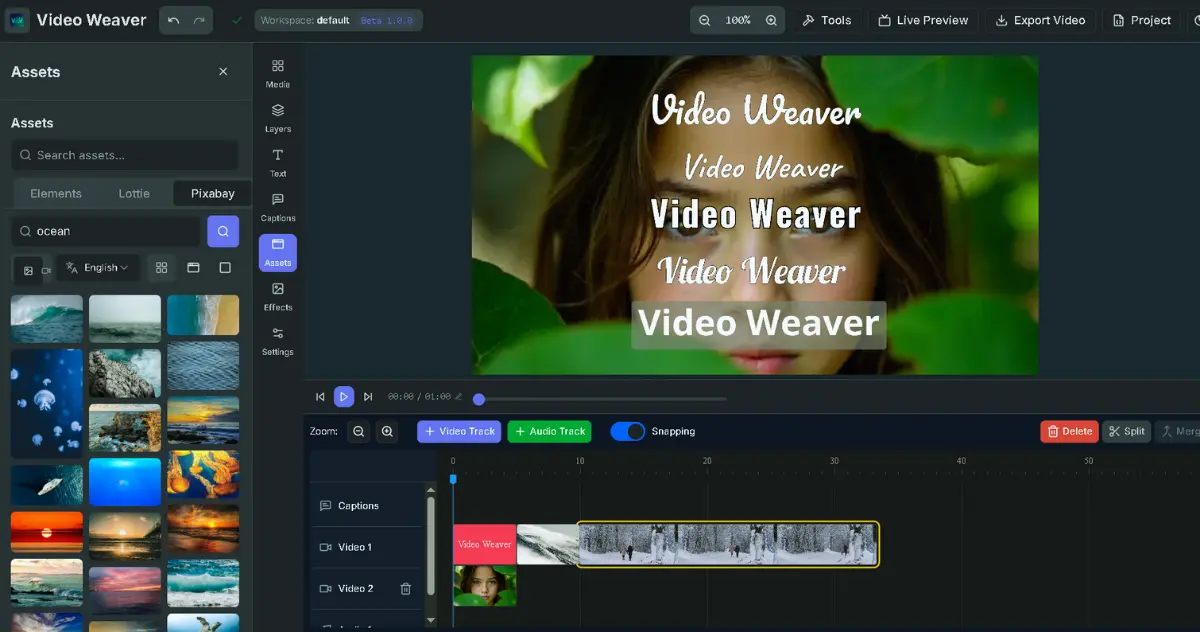The Open-Source Rising Star Shaking Up the AI World: BAGEL Multimodal Model Rivals GPT-4o and Gemini 2.0!
The open-source unified multimodal model BAGEL from ByteDance has officially launched! Not only does it boast capabilities comparable to GPT-4o and Gemini 2.0, but its native multimodal architecture also delivers stunning precision and realism in image generation. Now, with both code and models fully open-sourced, anyone can experience its brilliance!
What Is BAGEL? More Than Just a “Bagel”!
You’ve probably heard of various AI models, but BAGEL is one of the most exciting developments in recent times. Imagine a model that can understand text, images, and even video just like a human—and generate brand new content based on your instructions. That’s the core power of BAGEL: a Unified Multimodal Model.
“Multimodal” might sound technical, but it simply means the model can process multiple types of information. Just like humans can see with their eyes, hear with their ears, and speak with their mouths, BAGEL can “read” images, “understand” your text commands, and then “draw” new images—or even “chat” with you.
What’s even more impressive is BAGEL’s native multimodal architecture. That means it wasn’t cobbled together by merging separate models for text and images—it was designed from the ground up to unify both. This is like an athlete naturally ambidextrous—BAGEL handles text and image tasks more smoothly and efficiently, producing highly detailed and realistic results.
The development team from ByteDance officially released BAGEL on May 20, 2025. Their goal is clear: to offer an open-source alternative that matches or even surpasses top-tier commercial models like GPT-4o and Gemini 2.0. This means developers and researchers can freely fine-tune, optimize, and deploy BAGEL anywhere, without being locked into a specific platform.
Sounds cool, right? Let’s dive deeper into BAGEL’s incredible capabilities.
BAGEL’s Signature Features: Beyond Chatting—Creative and Playful!
BAGEL does far more than just answer questions. It’s like a versatile artist and thinker rolled into one, capable of handling many complex tasks. Here’s a look at some of its impressive “talents”:
Next-Level Conversations: Rich Text-and-Image Interactions
Of course, basic chatting is part of the package. You can ask BAGEL questions and get advice just like you would with a friend. But BAGEL takes it further by supporting mixed-format input and output. That means you can show it an image and ask, “What’s in this picture?” Or, provide a text description and have it generate an image, then continue the conversation based on that image.
For example, upload a photo of Michelangelo’s David and ask, “Tell me about this image.” BAGEL won’t just recognize it as David—it’ll tell you it’s a famous sculpture by Michelangelo and even explain its historical and artistic significance. Want more details about the artist? Just keep asking—BAGEL’s happy to help!
Generate Anything: From Text to Photo-Realistic Images
This is one of BAGEL’s most exciting features. Trained on massive, interleaved video and web datasets, it can generate highly realistic images, video frames, or rich multimedia content from text prompts.
What’s amazing is how these interleaved datasets enable the model to form a natural Multimodal Chain-of-Thought. In other words, BAGEL “thinks” before generating visual content, much like how a human would plan before creating art.
Try giving it a prompt like: “A photo of three antique glass magic potions in an abandoned old pharmacy: the first is blue with a label ‘SDXL’; the second is red labeled ‘BAGEL’; the third is green labeled ‘FLUX’.” You’ll be amazed at how accurately BAGEL understands the details and generates an atmospheric image that matches perfectly.
Intelligent Editing: Preserving Detail, Smart Adjustments
BAGEL isn’t just a creator—it’s also a brilliant image editor. Thanks to its pretraining on interleaved video clips, it naturally learns how to retain visual features and details during editing while capturing complex visual dynamics.
Even better, BAGEL leverages strong reasoning from its visual-language foundation, making its “smart editing” far more advanced than basic tools. Show it a portrait and say, “Make him crouch and pat the dog,” and BAGEL will understand and generate a convincing, natural-looking edit.
Style Transformer: Jump Across Artistic Realms
Want to turn the Mona Lisa into a 3D animated style? Easy for BAGEL! With a deep understanding of visual content and style, it can effortlessly convert images across styles—or even between completely different worlds—with minimal alignment data.
That means you can turn realistic photos into cartoons, oil paintings, or futuristic cyberpunk images. BAGEL puts your imagination on wings.
Free Navigation: From Virtual Worlds to Real-Life Scenes
Learning from videos, BAGEL extracts navigation knowledge from the ultimate simulator—reality itself. This allows it to navigate various environments, from sci-fi landscapes to artistic renderings, and present them in different angles or perspectives.
Imagine giving it a photo of an ancient street and saying “move forward after 0.4 seconds.” BAGEL can generate a short video or sequence simulating forward movement within the scene. This opens up new possibilities for interactive experiences and virtual world exploration.
Creative Continuity: Seamless Multi-Turn Dialogue
BAGEL learns extensively from video, web, and language data, enabling it to reason, simulate physics, predict future frames, and more—all through a unified multimodal interface.
Its strong compositional abilities allow it to follow multi-turn instructions seamlessly. For instance, you might first ask it to generate “an ethereal fairy or elf cosplayer in a flowing dress made of emerald and silver-toned delicate fabric, with pointed ears and a gentle, enchanting expression.” Then follow up with, “Make her into a Jellycat plush toy.” BAGEL understands and generates the new image accordingly. Want a catchy marketing line for the plush? It can suggest one like, “Fly into a world of imagination with our magical fairy doll!”
Deep Reasoning: Refining Prompts, Precision Outputs
BAGEL includes a “thinking mode” that enhances generation and editing through its multimodal reasoning. By reasoning through prompts, BAGEL can expand short descriptions into detailed, coherent outputs with rich context, accurate details, and logical consistency.
Say you ask for “a big car made out of many small cars.” BAGEL’s thinking mode understands the concept and generates an image where numerous tiny cars form the shape and structure of a larger car—exactly as you imagined.
The “Secret Sauce” Behind BAGEL: MoT and Continuous Learning
So how does BAGEL accomplish all this? The answer lies in its elegant design and training approach.
BAGEL uses a Mixture-of-Transformer-Experts (MoT) architecture to maximize learning from diverse multimodal data. It also leverages two independent encoders to capture pixel-level and semantic-level image features.
Its framework follows the Next Group of Token Prediction paradigm, training the model to predict the next group of language or visual tokens as a compression objective.
BAGEL extends MoT capabilities through pretraining, continued training, and supervised fine-tuning on trillions of interleaved multimodal tokens from language, image, video, and web sources. It outperforms existing open-source models on standard understanding and generation benchmarks and demonstrates advanced contextual multimodal skills like free-form image editing, future frame prediction, 3D manipulation, world navigation, and sequence reasoning.
Emergent Capabilities: Unfolding Step by Step
As BAGEL sees more multimodal tokens during pretraining, researchers observed steady improvements in understanding, generation, and editing. Different skills emerge at different training stages—multimodal understanding and generation appear early, followed by basic editing, with smart editing emerging later. This staged development shows how advanced reasoning builds on foundational skills.
Ablation studies show that combining VAE (Variational Autoencoder) and ViT (Vision Transformer) features significantly enhances smart editing. This highlights the importance of visual-semantic context in achieving sophisticated multimodal reasoning and supports its role in emergent capabilities.
Proof of Power: Benchmark Results Speak for Themselves
Talk is cheap—let’s look at how BAGEL performs on public benchmarks.
In understanding benchmarks like MME-P, MMBench, MMMU, and MMVet, BAGEL consistently ranks among the top, even surpassing models like Chameleon-7B, Emu3-8B, and MetaQuery-XL-7B. For instance, it scored 1687 on MME-P, 85 on MMBench, and 67.2 on MMVet.
In generation benchmarks—evaluating single-object, two-object, counting, color, and position tasks—BAGEL again excels, scoring 0.95 on both “two objects” and “color,” and 0.84 on “counting.” These results highlight its robust generation abilities.
This data firmly positions BAGEL as a top-tier open-source multimodal model.
Become a “Bagel Master”: Open Source & Online Demo
Perhaps the most exciting aspect of BAGEL is its open-source nature. Developers, researchers, and AI enthusiasts around the world can access its code on GitHub and model. You’re free to explore its internals, build on top of it, or integrate it into your own projects.
Want to try BAGEL right now? The team also offers an online demo. No complex setup needed—interact with BAGEL directly in your browser and witness its powerful image-text comprehension and generation firsthand.
BAGEL’s arrival injects fresh energy into the open-source AI community. Not only does it rival leading commercial models, but more importantly, it puts that power in everyone’s hands. We can expect countless innovations built on BAGEL to drive the future of multimodal AI. So, are you ready to take a bite of this powerful, delicious BAGEL?




